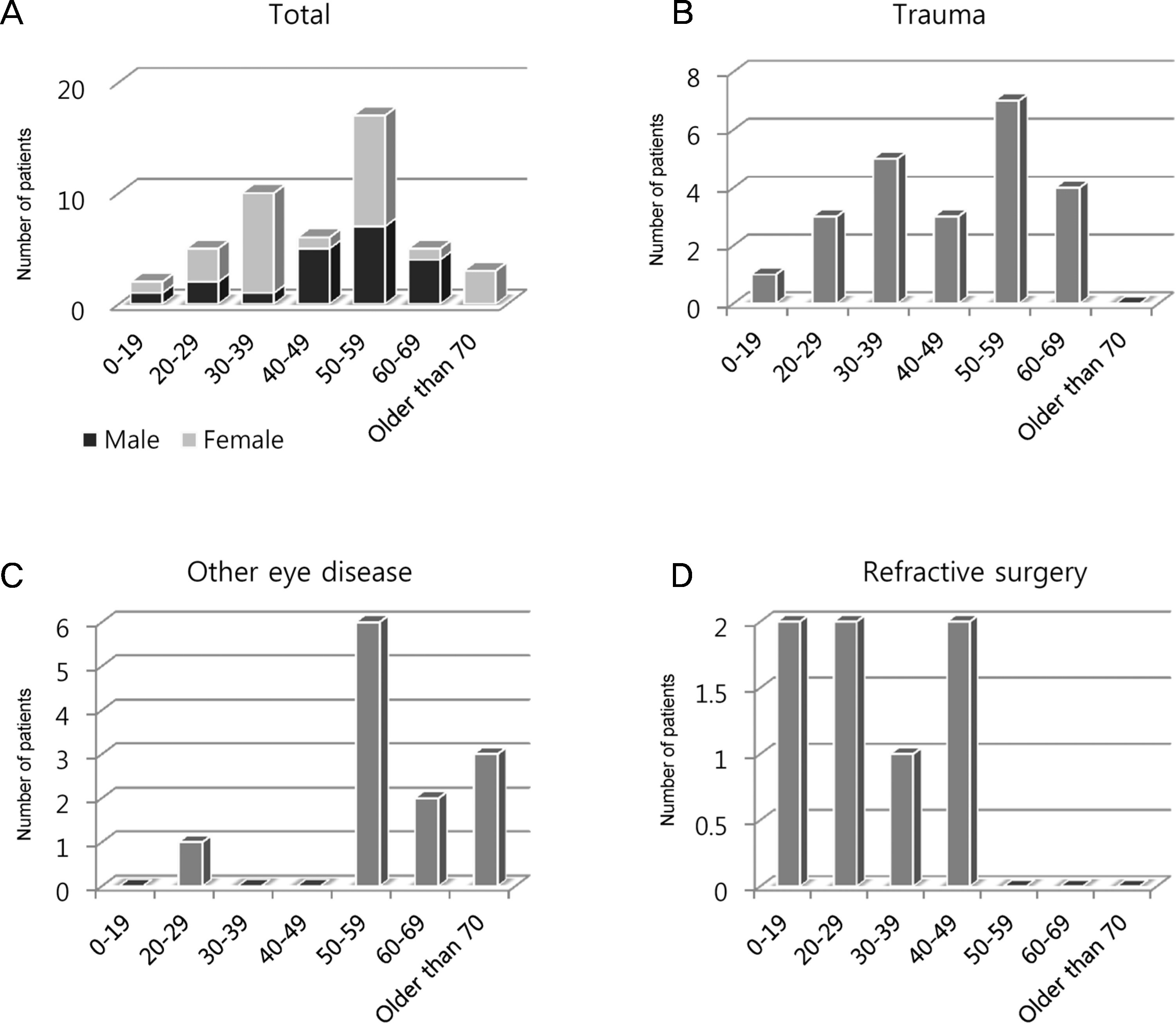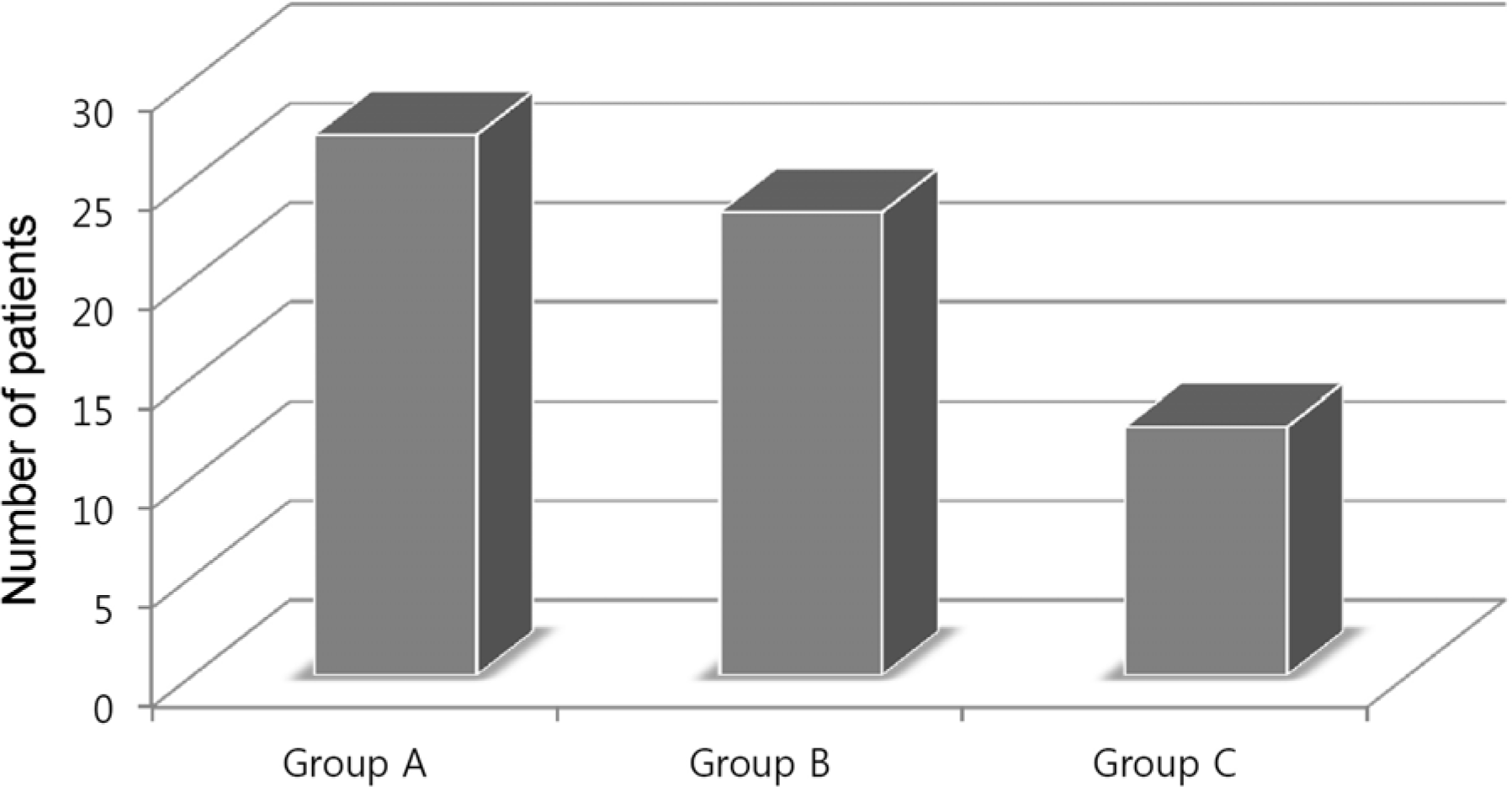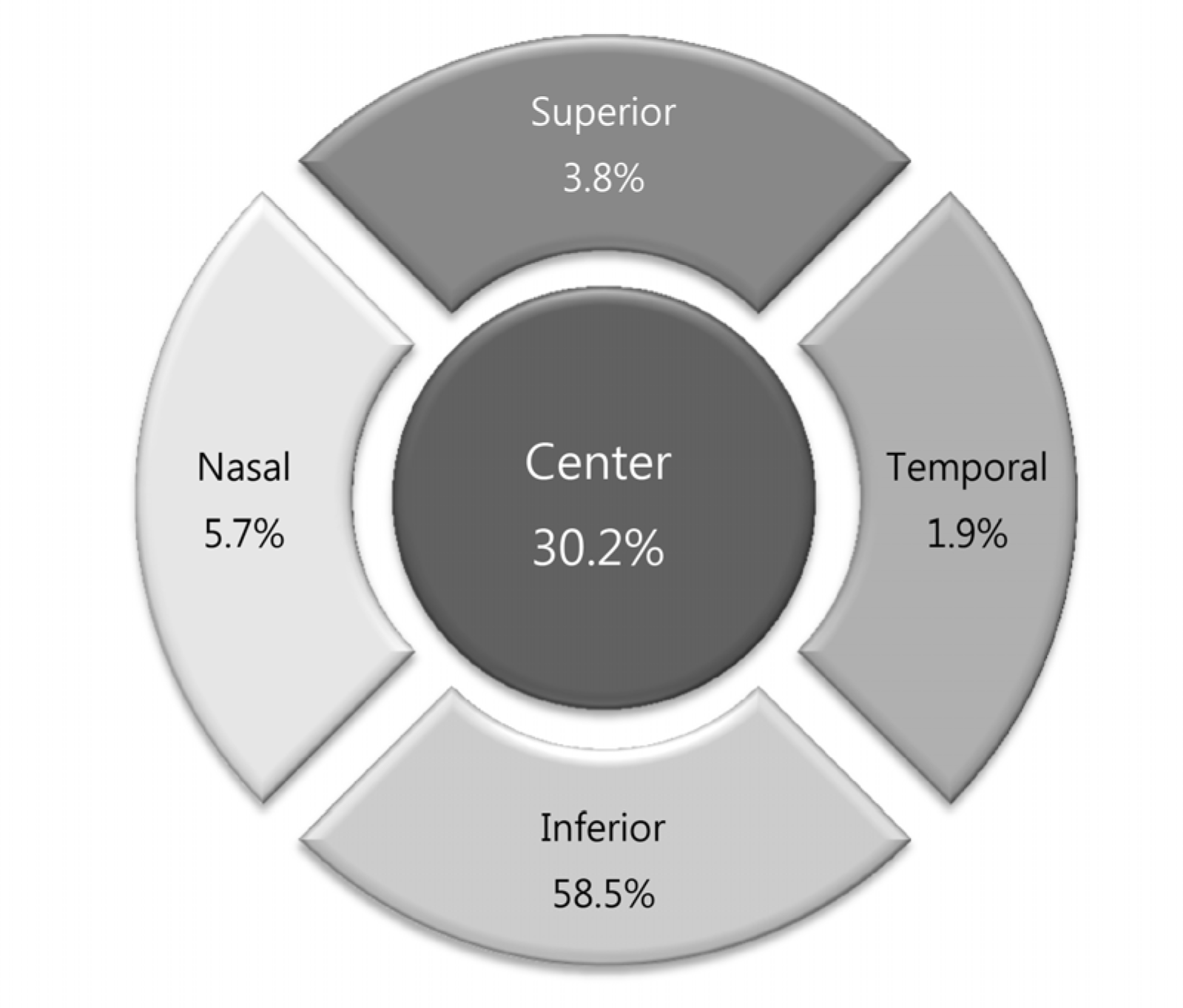Abstract
Purpose
To investigate the clinical presentation and treatment outcomes of recurrent corneal erosion patients.
Methods
Retrospective analysis was performed on the medical records of 48 patients (53 eyes) diagnosed with recurrent corneal erosion by our ophthalmology department between January 2008 and March 2015. Patient age, gender, lesion location, and cause of disease were analyzed against occurrence of disease. Patients were classified by treatment method into group A, which was treated with eye drops; group B, which was treated with therapeutic contact lenses and eye drops; group C, which was treated with amniotic membrane transplantation; and group D, which was treated with other procedures, and the recurrence rates were compared.
Results
The mean age of patients was 45.6 ± 14.3 years (19-76 years), with no significant difference in recurrence rates dependent on gender or eye. Patients in their 50s were most affected, excluding refractive surgery patients. The most frequent lesion location was the inferior area of the cornea (58.5%), followed by the central area (30.2%), and the most common cause of disease was trauma, followed by unknown causes, past refractive surgery, and complications from other eye diseases. Group A had 11 eyes (20.8%), while groups B, C, and D had 30 eyes (56.6%), 8 eyes (15.1%) and 4 eyes (7.3%), respectively. The recurrence rates according to treatment method were 27.3% in group A, 23.3% in group B, and 12.5% in group C. The lower recurrence rate in the group treated with amniotic membrane transplantation was not significant compared to that of conservatively treated groups.
Conclusions
Recurrent corneal erosion mostly affects patients in their 50s, excluding refractive surgery patients, and occurs frequently in the inferior area of the cornea due to mild trauma. Surgical treatment including amniotic membrane transplantation should be considered instead of conservative treatment in order to prevent reoccurrence.
References
1. Thomas OW. Recurrent erosion. Tr Am Ophth Soc. 1984; 82:850–98.
2. Suh Y, Kim MS. The longterm evaluation of recurrent corneal erosion. J Korean Ophthalmol Soc. 2002; 43:1570–6.
3. Diez-Feijóo E, Grau AE, Abusleme EI, Durán JA. Clinical presentation and causes of recurrent corneal erosion syndrome: review of 100 patients. Cornea. 2014; 33:571–5.
4. Lee SH, Kim TI, Chung SH, et al. A case of combined bacterial keratitis with recurrent corneal erosion. J Korean Ophthalmol Soc. 2007; 48:449–54.
5. Reeves SW, Kang PC, Zlogar DF, et al. Recurrent corneal erosion syndrome: a study of 364 episodes. Ophthalmic Surg Lasers Imaging. 2010; Mar 9. 1–2. doi: 10.3928/15428877-20100215-44. [Epub ahead of print].

6. Diez-Feijóo E, Durán JA. Optical coherence tomography findings in recurrent corneal erosion syndrome. Cornea. 2015; 34:290–5.

7. Sakimoto T, Shoji J, Yamada A, Sawa M. Upregulation of matrix metalloproteinase in tear fluid of patients with recurrent corneal erosion. Jpn J Ophthalmol. 2007; 51:343–6.

8. Kameishi S, Sugiyama H, Yamato M, et al. Remodeling of epithelial cells and basement membranes in a corneal deficiency model long-term follow-up. Lab Invest. 2015; 95:168–79.
9. Eke T, Morrison DA, Austin DJ. Recurrent symptoms following traumatic corneal abrasion: prevalence, severity, and the effect of a simple regimen of prophylaxis. Eye (Lond). 1999; 13(Pt 3a):345–7.

10. Ewald M, Hammersmith KM. Review of diagnosis and management of recurrent erosion syndrome. Curr Opin Ophthalmol. 2009; 20:287–91.

11. Dursun D, Kim MC, Solomon A, Pflugfelder SC. Treatment of recalcitrant recurrent corneal erosions with inhibitors of matrix met-alloproteinase-9, doxycycline and corticosteroids. Am J Ophthalmol. 2001; 132:8–13.

12. Wang L, Tsang H, Coroneo M. Treatment of recurrent corneal erosion syndrome using the combination of oral doxycycline and topical corticosteroid. Clin Experiment Ophthalmol. 2008; 36:8–12.

13. Ziakas NG, Boboridis KG, Terzidou C, et al. Long-term follow up of autologous serum treatment for recurrent corneal erosions. Clin Experiment Ophthalmol. 2010; 38:683–7.

14. Yoon KC, Choi W, You IC, Choi J. Application of umbilical cord serum eyedrops for recurrent corneal erosions. Cornea. 2011; 30:744–8.

15. Moutray TN, Frazer DG, Jackson AJ. Recurrent erosion syndrome–the patient's perspective. Cont Lens Anterior Eye. 2011; 34:139–43.
16. Fraunfelder FW, Cabezas M. Treatment of recurrent corneal erosion by extended-wear bandage contact lens. Cornea. 2011; 30:164–6.

17. Ahad MA, Anandan M, Tah V, et al. Randomized controlled study of ocular lubrication versus bandage contact lens in the primary treatment of recurrent corneal erosion syndrome. Cornea. 2013; 32:1311–4.

18. Singh RP, Raj D, Pherwani A, et al. Alcohol delamination of the corneal epithelium for recalcitrant recurrent corneal erosion syndrome: a prospective study of efficacy and safety. Br J Ophthalmol. 2007; 91:908–11.

19. Ryan G, Lee GA, Maccheron L. Epithelial debridement with diamond burr superficial keratectomy for the treatment of recurrent corneal erosion. Clin Experiment Ophthalmol. 2013; 41:621–2.

20. Avni Zauberman N, Artornsombudh P, Elbaz U, et al. Anterior stromal puncture for the treatment of recurrent corneal erosion syndrome: patient clinical features and outcomes. Am J Ophthalmol. 2014; 157:273–9.e1.

21. Tsai TY, Tsai TH, Hu FR, et al. Recurrent corneal erosions treated with anterior stromal puncture by neodymium: yttrium-aluminum-garnet laser. Ophthalmology. 2009; 116:1296–300.

22. Kim SY, Ko BY. Evaluaion of anterior stromal puncture using Nd: YAG laser for refractory recurrent corneal erosion. J Korean Ophthalmol Soc. 2015; 56:331–8.
23. Choi M, Jung JW, Seo KY, et al. Comparison of Nd: YAG laser versus conservative management in the treatment of recurrent corneal erosion. J Korean Ophthalmol Soc. 2015; 56:687–93.
24. Ko BY, Lee GW. Clinical results of phototherapeutic keratectomy for refractory recurrent corneal erosion. J Korean Ophthalmol Soc. 2011; 52:392–400.

25. Kim JC, Tseng SC. Transplantation of preserved human amniotic membrane for surface reconstruction in severely damaged rabbit corneas. Cornea. 1995; 14:473–84.

26. Lee KH, Lee DW, Kim IC. The clinical effect of amniotic membrane transplantation for various ocular surface diseases. J Korean Ophthalmol Soc. 2007; 48:7–12.
27. Malhotra C, Jain AK. Human amniotic membrane transplantation: different modalities of its use in ophthalmology. World J Transplant. 2014; 4:111–21.

28. Koizumi NJ, Inatomi TJ, Sotozono CJ, et al. Growth factor mRNA and protein in preserved human amniotic membrane. Curr Eye Res. 2000; 20:173–7.

29. Fukuda K, Chikama T, Nakamura M, Nishida T. Differential distribution of subchains of the basement membrane components type IV collagen and laminin among the amniotic membrane, cornea, and conjunctiva. Cornea. 1999; 18:73–9.

30. Meller D, Pires RT, Mack RJ, et al. Amniotic membrane transplantation for acute chemical or thermal burns. Ophthalmology. 2000; 107:980–9. discussion 990.

31. Lee HS, Oh HJ, Yoon KC. Phototherapeutic keratectomy with or without amniotic membrane transplantation for symptomatic bullous keratopathy. J Korean Ophthalmol Soc. 2013; 54:1180–6.

32. Yeom HY, Park SB, Lee HK, Kim EK. Effects of amniotic membrane after LASEK on epithelial healing, clinical and refractive outcomes. J Korean Ophthalmol Soc. 2004; 45:195–202.
Figure 1.
Etiology and age distribution at the time of diagnosis of recurrent corneal erosion. Age distribution of (A) 53 total patients, (B) trauma group, (C) other eye disease group, and (D) refractive surgery.

Figure 2.
Comparison of recurrence rate of conservative treatment and amniotic membrane transplantation. ‘Group A’ is ‘conservative treatment with eye drops only’, ‘Group B’ is ‘conservative treatment with eye drops and contact lens’ and ‘Group C’ is ‘amniotic membrane transplantation’.

Table 1.
Causative factors in 53 eyes of 48 patients with recurrent corneal erosion
| Causative factors | No. of eyes (%) | Bilateral (No. of patients) |
|---|---|---|
| Trauma | 23 (43.4) | 1 |
| Other eye disease | 12 (22.6) | 2 |
| Unknown origin | 9 (17.0) | 0 |
| Refractive surgery | 7 (13.2) | 2 |
| Corneal dystrophy | 2 (3.8) | 0 |
Table 2.
Distributions of other eye diseases that cause recurrent corneal erosion




 PDF
PDF ePub
ePub Citation
Citation Print
Print



 XML Download
XML Download